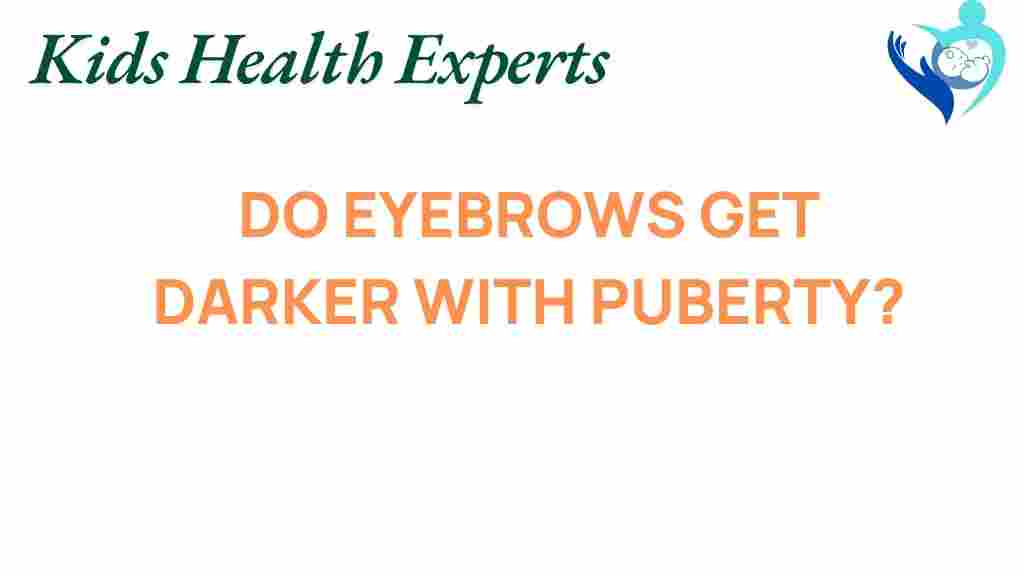Do Eyebrows Transform During Puberty?
Puberty is a pivotal period in youth development marked by numerous physical and emotional changes. Among these transformations, many people wonder about the evolution of their eyebrows. Do eyebrows change during puberty? What causes these changes? In this article, we will delve into the science behind how eyebrows are affected during puberty, examining the role of hormonal changes, genetics, and other factors.
The Role of Hormonal Changes in Eyebrow Development
During puberty, the body undergoes significant hormonal changes that contribute to various physical developments, including hair growth. These hormonal fluctuations can lead to observable changes in eyebrows:
- Increased Androgens: The surge in hormones such as testosterone in boys and increased estrogen in girls can stimulate hair follicles, leading to thicker, darker, or more defined eyebrows.
- Changes in Hair Color: Some adolescents notice a change in the color of their eyebrows, which can be attributed to hormonal influences and genetics.
- Variations in Hair Texture: The texture of eyebrow hair may also change, becoming coarser or curlier as hormonal levels fluctuate.
Genetics: The Blueprint of Your Eyebrows
Genetics plays a crucial role in determining the characteristics of your eyebrows throughout your life, including during puberty. Key genetic factors include:
- Inherited Traits: The shape, thickness, and color of your eyebrows are often inherited from your parents. If your parents had bushy eyebrows, there’s a good chance you might too.
- Ethnic Background: Different ethnic groups have distinct eyebrow characteristics, which can influence how your eyebrows develop during adolescence.
- Family Patterns: If there is a family history of certain eyebrow traits, these may become more pronounced during puberty.
Body Changes and Their Effect on Eyebrows
As adolescents grow, other body changes can impact the appearance and health of eyebrows:
- Nutritional Factors: A balanced diet rich in vitamins and minerals plays a vital role in hair growth. Deficiencies can lead to thinning eyebrows.
- Skincare Routines: The use of skincare products can affect the skin around the eyebrows, potentially leading to changes in how they look during puberty.
- Overall Health: Physical health, including hormonal imbalances or stress levels, can influence hair growth patterns, including the eyebrows.
The Stages of Eyebrow Transformation During Adolescence
Understanding the stages of eyebrow transformation can help adolescents and their guardians navigate this natural process:
- Early Adolescence (Ages 10-12): In this stage, minor changes may occur, but they are often subtle. Eyebrows may start to fill in as the body begins to produce more hormones.
- Middle Adolescence (Ages 13-15): This is when most noticeable changes occur. Eyebrows may become thicker, darker, and more defined due to increased androgen levels.
- Late Adolescence (Ages 16-18): By this stage, eyebrows may stabilize in thickness and shape, though some may continue to evolve due to ongoing hormonal changes.
How to Care for Eyebrows During Puberty
Maintaining healthy eyebrows during puberty is essential for both appearance and confidence. Here are some tips for care:
- Regular Grooming: Trimming or plucking eyebrows can help maintain their shape, but it’s important to avoid over-grooming.
- Moisturizing: Keeping the skin around the eyebrows moisturized can promote healthy hair growth.
- Healthy Diet: Incorporate foods rich in vitamins A, C, and E, as well as biotin, to support hair health.
Troubleshooting Common Eyebrow Issues During Adolescence
Many adolescents experience common eyebrow issues during puberty. Here are some solutions:
- Thinning Eyebrows: If eyebrows appear thinner, consider reviewing your diet for deficiencies in essential nutrients. Supplements like biotin may help.
- Unruly Hair: For eyebrows that seem wild or unmanageable, regular grooming and the use of eyebrow gels can assist in keeping them in place.
- Color Changes: If you notice significant changes in eyebrow color, consult a dermatologist to rule out any health concerns.
Understanding the Psychological Impact of Eyebrow Changes
The transformation of eyebrows during puberty can also have psychological effects. Adolescents are often sensitive to changes in their appearance, which can impact self-esteem:
- Body Image: Changes in eyebrows can contribute to overall body image perceptions. Encouragement and support from family and friends can help.
- Social Influences: Media portrayals of beauty can lead adolescents to feel pressure regarding their appearance, including their eyebrows.
- Peer Comparisons: Adolescents may compare their eyebrows to those of their peers, affecting their self-esteem and confidence.
For more in-depth information on youth development and other related topics, check out this comprehensive resource.
Conclusion: Embracing Change and Growth
In conclusion, eyebrows do transform during puberty due to hormonal changes, genetics, and various body changes. Understanding these transformations can empower adolescents to embrace their evolving appearances and foster a positive self-image. Proper care and awareness of eyebrow health can make a significant difference during this formative time. As youth navigate adolescence, it’s important to remember that these changes are a natural part of growing up.
For further reading on related topics, visit this informative website.
This article is in the category Growth and created by KidsHealthExperts Team
